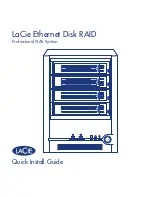
Chapter 4. Web Configuration & Operation
223
CHAPTER 4
WEB OPERATION & CONFIGURATION
Trap Config Name:
Indicates a descriptive name for this SNMP trap entry.
Trap Mode:
Indicates the SNMP trap mode operation.
Enabled:
Enable SNMP trap mode operation.
Disabled:
Disable SNMP trap mode operation.
Trap Version:
Indicates the SNMP trap supported version. Possible versions are:
SNMP v1:
Set SNMP trap supported version 1.
SNMP v2c:
Set SNMP trap supported version 2c.
SNMP v3:
Set SNMP trap supported version 3.
Trap Community:
Indicates the community access string when sending SNMP trap packet. The allowed string length is
0 to 255, and the allowed content is ASCII characters from 0x21 to 0x7E.
Trap Destination Address:
Indicates the SNMP trap destination address. It allows a valid IP address in dotted decimal
notation ('x.y.z.w'). Also allowed is a valid hostname. A valid hostname is a string drawn from the alphabet (A-Z; a-z),
digits (0-9), dot (.) and dash (-). Spaces are not allowed. The first character must be an alpha character, and the first
and last characters cannot be a dot or a dash.
Trap Destination port:
Indicates the SNMP trap destination port. SNMP Agent will send SNMP message via this port,
the port range is 1~65535. The default SNMP trap port is 162.
Trap Inform Mode:
Indicates the SNMP trap inform mode operation. Possible modes are:
Enabled:
Enable SNMP trap inform mode operation.
Disabled:
Disable SNMP trap inform mode operation.
Trap Inform Timeout (seconds):
Indicates the SNMP trap inform timeout. The allowed range is 0 to 2147.
Trap Inform Retry Times:
Indicates the SNMP trap inform retry times. The allowed range is 0 to 255.
Trap Probe Security Engine ID:
Indicates the SNMP trap probe security engine ID mode of operation. Possible values
are:
Enabled:
Enable SNMP trap probe security engine ID mode of operation.
Disabled:
Disable SNMP trap probe security engine ID mode of operation.
Trap Security Engine ID:
Indicates the SNMP trap security engine ID. SNMPv3 sends traps and informs use USM for
authentication and privacy. A unique engine ID for these traps and informs is needed. When "Trap Probe Security
Engine ID" is enabled, the ID will be probed automatically. Otherwise, the ID specified in this field is used. The string
must contain an even number (in hexadecimal format) with number of digits between 10 and 64, but all-zeros and all-
'F's are not allowed.
Trap Security Name:
Indicates the SNMP trap security name. SNMPv3 traps and informs use USM for authentication
and privacy. A unique security name is needed when traps and informs are enabled.
Summary of Contents for MSW-4424C Series
Page 1: ...1 MSW 4424C MSW 4424CS L2 Gigabit Carrier Ethernet Switch ...
Page 382: ......
















































